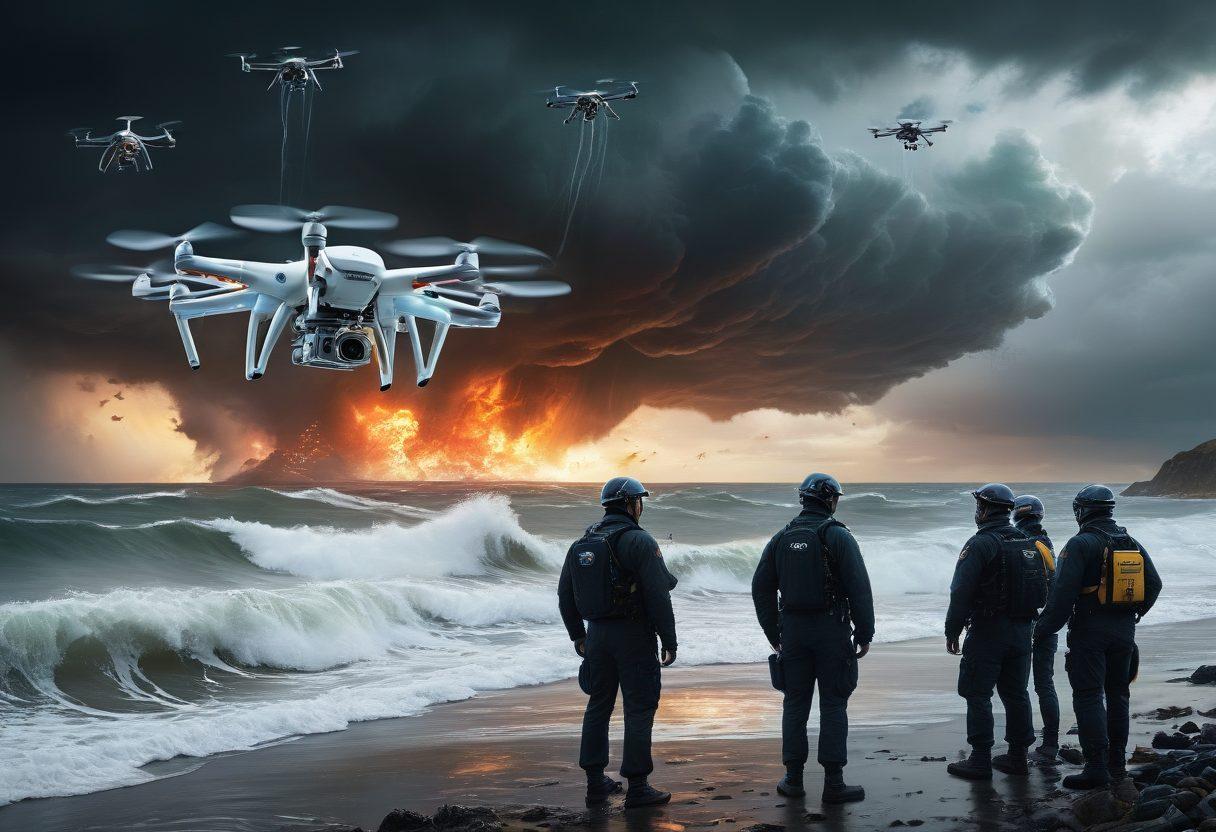Navigating the Waves of Safety: How Modern Technology Transforms Emergency Communication and Location Tracking
Imagine being adrift in turbulent waters, where every wave feels like an echo of uncertainty. In such moments, the guiding light of a lighthouse can mean the difference between safety and peril. Similarly, in our daily lives, the advancement of technology acts as our modern lighthouse, providing crucial guidance through the fog of emergencies. As the world becomes increasingly interconnected, the role of communication technology in delivering swift and reliable emergency alerts has never been more vital. How do these systems function like lighthouses in our digital landscape?
At the heart of this transformation lies the power of real-time tracking and geolocation. Picture this: you're lost in a city you barely know, and a simple swipe on your smartphone can pinpoint your location with astonishing accuracy. These capabilities extend far beyond navigation; they enable emergency signal transmission and status updates during crises. The integration of location tracking into emergency notification systems serves not just as a convenience, but as a vital protection mechanism. Have you ever wondered how a safety alert can be triggered in seconds?
The seamless blend of digital communication and environmental detection has redefined how we view safety. With advances in monitoring technologies, cities can now deploy surveillance systems that detect anomalies in real-time. Imagine a system that can differentiate between normal and abnormal activities in a public space, sending out a warning to both authorities and civilians. This kind of proactive communication can serve as a powerful indicator of potential dangers. It raises an intriguing question: What if this level of vigilance could be the new standard in fostering safer communities?
The emotional weight of waiting for an emergency signal can be unbearable. In an age where information is at our fingertips, we expect prompt and clear communication when it matters most. Today’s alert systems are engineered for rapid responses, designed to convey crucial messages quickly and efficiently. Think about the last time you received an emergency alert on your phone. Did the clarity of that message give you a sense of security? This immediate communication fosters confidence, assuring individuals that help is within reach.
From community outreach to personal safety, the role of technology in emergency alerts spans a vast spectrum. As we embrace these advancements, we must think critically about how they serve us. Are we equipped to respond effectively when those alerts come in? Are we aware of the options available for effective safety communication? Understanding how these systems work not only empowers us but also increases our readiness to respond in times of crisis. Ultimately, in this age of innovation, we hold the power to harness technology for our protection, ensuring that the light shines brightly on our paths toward safety and security.
From Lighthouses to Smartphones: Revolutionizing Emergency Communication
Once upon a time, before smartphones and satellites, the lighthouse stood as a beacon of hope and guidance for sailors navigating treacherous waters. These tall structures became the epitome of safety, projecting warning signals across miles of sea. Fast forward to today, and we see how our reliance on such physical indicators has evolved. With the advancements in communication technology, our approach to emergency notification and location tracking has undergone a monumental transformation, introducing innovative ways to protect and connect us in times of crisis.
Imagine being on a boat, surrounded by heavy fog, and suddenly your vessel’s GPS system blinks a warning about incoming storms. That’s digital communication at work, turning data into an actionable safety alert. With integrated geolocation tools, technology now acts as our mental lighthouse, offering real-time tracking and ensuring we are never truly lost at sea. In a way, smartphones have become the modern equivalent of those majestic lighthouses, providing a constant stream of information and support whenever we need it most.
Have you ever received an emergency message that changed your day—a safety communication that told you about a natural disaster or a severe weather alert? The information transmitted has the power not just to inform but also to save lives. Today, sophisticated surveillance systems monitor environmental detection, allowing for a quicker response signal. When seconds count, these technologies can mean the difference between safety and disaster. It’s fascinating how something as simple as a status update on your device can set off an entire alert system, mobilizing help faster than ever before.
While we’ve made incredible strides in emergency communication, it's important to remember the human aspect behind the technology. What truly counts is our response to these alerts. We often find ourselves asking, “How do I prepare for these situations?” The answer lies in understanding our tools—dive into the settings of your smartphone, get familiar with local emergency resources, and don’t forget the traditional methods of communication. Just as our ancestors relied on the sight of lighthouses against rocky coastlines, we too must recognize and respect the systems designed for our protection.
As we sail further into this digital age, one can’t help but wonder: what’s next for emergency response technology? The marriage of artificial intelligence and real-time tracking sounds promising, yet raises questions about privacy and data management. For every advancement in safety, there’s a responsibility to utilize it wisely. What will your lighthouse be in this new world of emergency communication? Embrace the tools, stay informed, and always be ready to send out your own emergency signal when needed. In the end, we’re all navigating these waves together, striving for safety and connection.
Navigating Real-Time Responses: How Geolocation Enhances Safety Monitoring
In a world where uncertainty often looms, the age-old metaphor of a lighthouse serving as a beacon of safety has never felt more relevant. Just as these tall structures guide ships through treacherous waters, modern communication technology, especially geolocation, acts as our contemporary lifeguard in the sea of everyday risks. Can you imagine a future where emergency signals and safety alerts are transmitted in real-time, transforming the way we respond to life-threatening situations? This isn’t just a dream but a reality that’s rapidly unfolding before us, reshaping safety monitoring and providing the necessary guidance to navigate personal safety through the stormy seas of uncertainty.
Geolocation technologies have made significant strides over the years, evolving from rudimentary location tracking systems to sophisticated tools capable of precise surveillance and environmental detection. Whether you’re hiking in the wilderness or navigating through city streets, the ability to receive a timely message regarding a potential danger is invaluable. Remember the last time you received an emergency notification just before a severe thunderstorm hit? That was geolocation at work, a modern warning signal that empowered you to seek shelter, proving that technology constantly enhances our protection. But how does this really work, and how can we capitalize on these advancements to ensure our safety?
Imagine a scenario where every time you set out on an adventure, you have an invisible guardian by your side. With modern geolocation services, this is possible! Real-time tracking means that your loved ones can monitor your status update, ensuring they receive alerts if you stray off your planned path or encounter an unexpected situation. What if we told you that this same technology has applications in urban safety? Cities are implementing alert systems leveraging these capabilities to provide citizens with critical information about emergencies, from natural disasters to civil disturbances. It’s almost like having a lighthouse guiding you through the complexities of urban life.
The beauty of a robust communication system lies in its ability to connect and protect. The transmission of messages, whether they’re safety communication alerts or emergency notifications, can now happen in fractions of a second. This allows for swift responses to unforeseen events. For instance, consider how many lives could be saved if an emergency signal could instantly notify first responders of your exact location when you’re in distress. How comforting is it to know that technology can serve as both an indicator of danger and an assurance of support?
To fully utilize this transformation in emergency response, it’s vital for us to engage and educate ourselves about the tools available. There is no denying that integrating geolocation into our safety protocols can be a game-changer. But it requires us to stay informed about advancements in communication technology and be proactive about using systems designed for our protection. So, the next time you embark on a journey, remember the importance of safety monitoring and ask, 'Am I equipped for any real-time response that might arise?' And if the answer is no, take a moment to reassess your emergency plan and embrace the magical world of technology that offers guidance even when the path ahead seems perilous.


